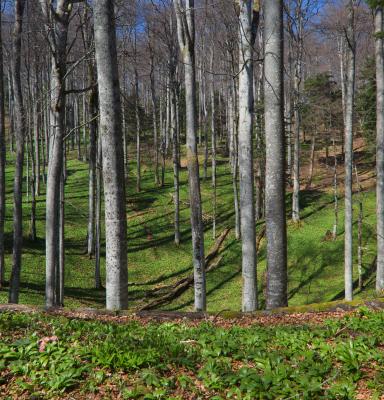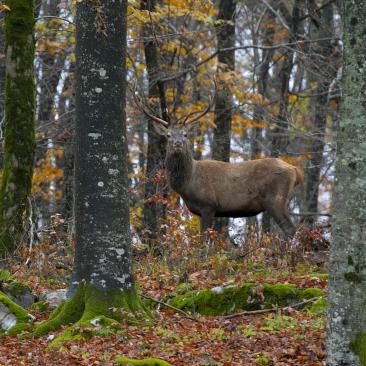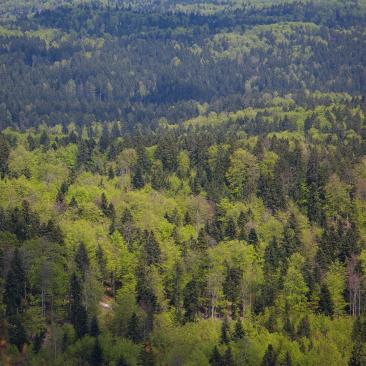

What is a forest ecosystem?
A forest ecosystem describes the community of plants, animals, microbes and all other organisms in interaction with the chemical and physical features of their environment: specifically, a terrestrial environment dominated by trees growing in a closed canopy — a forest, in other words.
The organisms involved in a forest ecosystem are interdependent on one another for survival and can be broadly classified according to their ecological role as producers, consumers and decomposers.
A forest ecosystem may be as small as a tree branch microsite where mosses, insects, and microscopic organisms interact or as large as the boreal forest that encircles the Earth at northern latitudes. The larger it is, the more complex the potential interactions.

Why is this concept important?
Forests are more than just trees, they are crucial for our survival and development. Understanding forests as forest ecosystems benefits us in numerous ways:
- Expanding our idea of a forest. Seeing a forest as a complex system of various and simultaneous interactions makes us appreciate and value forests on a whole new level.
- Appreciating a wide spectrum of forest ecosystem services. Humankind and ecosystems are strongly interrelated in a multitude of ways. Direct and indirect benefits from ecosystems are known as ecosystem services.
- Guiding our understanding of a responsible forest management. Understanding the complexity of forest ecosystems enriches our forest management practices to always consider vital habitats for a multitude of animal and plant species, water flow regulation, supply of clean air, soil formation and many other factors.
Types of forest ecosystems
Forests exist in all types of climate, whether dry, wet, extremely cold or extremely hot. The beauty of forest ecosystems lies in their diversity. According to their distance from the equator, they can be classified into three major types – tropical forest ecosystem, temperate forest ecosystem and boreal forest ecosystem.

The Tropical forests mainly exist around the equator in places like South America, Africa, Amazon region, and Southeast Asia. They have the maximum species diversity per area in the world.
Here, it rains a lot throughout the year but the temperature remains stable around 27°C. Generally, these forests have two seasons, namely rainy and dry.
The temperature, rainfall and twelve hours of daylight stimulate the growth of up to 100 different species of trees. Some of them are broadleaf trees, mosses, ferns, palms, and orchids.
These trees grow very densely and block most of the light from penetrating into it. One can also find animals such as snakes, frogs, lizards, monkeys, anacondas, jaguars, and small mammals in these forests.
Due to nutrient leaching, the soil of these forests lacks maximum essential nutrients which in turn make it useless for agriculture only after a few years of use. Thus, the topsoil gets depleted soon.

We can find temperate forests in North America, northeastern Asia, and Europe. In these forests, there are four seasons. Generally, the temperature here ranges from -30 to 30°C.
These forests receive rainfall of around 75-150cm. Usually, one can find only 3-4 species of trees on an average per square km.
Deciduous or leaf shedding trees form a large proportion of trees. Coniferous trees such as pines and firs also grow here. Some of the common trees are oak, beech, elm, maple, birch, willow, and hickory.
Some of the commonly found animals are rabbits, birds, squirrels, deer, wolves, foxes, and bears. Both, the plants and the animals are adaptive to the cold winters and warm summer weather. The soil of these forests is fertile due to the combination of decaying fallen leaves and the moderate temperatures.

Usually, we can find them between 50 to 60 degrees of latitude in the sub-Arctic zone which comprises of Siberia, Scandinavia, Alaska, and Canada. These have two seasons namely, a short, moist and mildly-warm summer and a long, cold and dry winter.
The temperature here ranges from -40 to 20°C. One can find evergreen conifers here with needle leaves that are capable to stand the cold, such as pine, fir, and spruce trees.
Some of the animals that live here are deer, wolverines, caribou, bats, small mammals, birds, moose, bears, lynx, wolf, etc. that can bear long and cold winters. These animals usually have thick fur or other insulation.
However, the soil has a very thin layer and is poor in nutrients and acidic. Also, the canopy here does not allow the sunlight to penetrate into the ground and thus there is very little growth of the understory.
